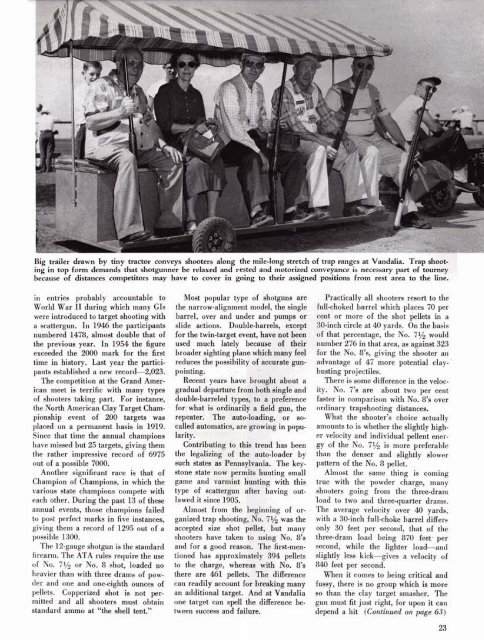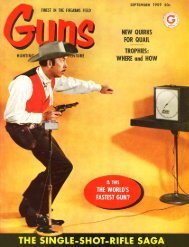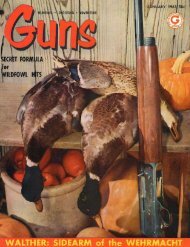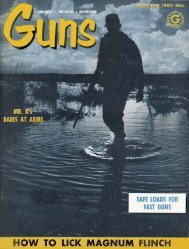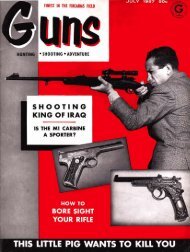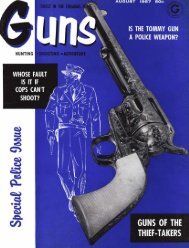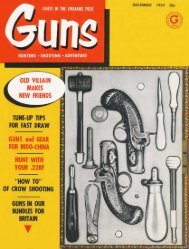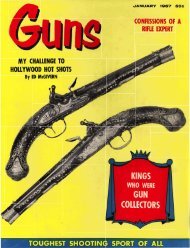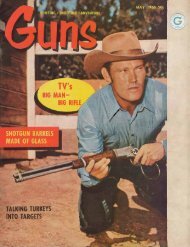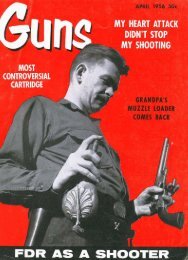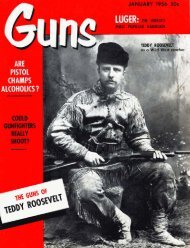Create successful ePaper yourself
Turn your PDF publications into a flip-book with our unique Google optimized e-Paper software.
Big trailer drawn by tiny tractor conveys shooters- along the mile-long stretch of trap ranges at Vandalia. Trap shoot-<br />
ing in top form demands that shotgunner be relaxed and rested and motorized conveyance is necessary .part of tourney<br />
because of distances competitors may have to cover in going to their assigned positions from rest area to the line.<br />
in entries probably accountable to<br />
World. War I1 during which many GIs<br />
were introduced to target shooting with<br />
a scattergun. In 1946 the participants<br />
numbered 1478, almost double that of<br />
the previous year. In 1954 the figure<br />
exceeded the 2000 mark for the first<br />
time in history. Last year the partici-<br />
pants established a new record-2,023.<br />
The comnetition at the Grand Amer-<br />
ican meet is terrific with many types<br />
of shooters taking part. For instance,<br />
the North American Clay Target Chain-<br />
pionship event of 200 targets was<br />
placed on a permanent basis in 1919.<br />
Since that time the annual champions<br />
have missed but 25 targets, giving them<br />
the rather impressive record of 6975<br />
out of a possible 7000.<br />
Another significant race is that of<br />
Champion of Champions, in which the<br />
various state champions compete with<br />
each other. During the past 13 of these<br />
annual events, those champions failed<br />
to post perfect marks in five instances,<br />
giving them a record of 1295 out of a<br />
possible 1300.<br />
The 12-gauge shotgun is the standard<br />
firearm. The ATA rules require the use<br />
of No. 7y2 or No. 8 shot, loaded no<br />
heavier than with three drams of pow-<br />
der and one and one-eighth ounces of<br />
pellets. Copperized shot is not per-<br />
mitted and all shooters must obtain<br />
standard ammo at "the shell tent."<br />
Most popular type of shotguns are<br />
the narrow-alignment model, the single<br />
barrel, over and under and pumps or<br />
slide actions. Double-barrels, except<br />
for the twin-target event, have not been<br />
used much lately because of their<br />
broader sighting plane which many feel<br />
reduces the possibility of accurate gun-<br />
pointing.<br />
Recent years have brought about a<br />
gradual departure from b$h single and<br />
double-barreled types, to 'a preference<br />
for what is ordinarily a field gun, die<br />
repeater. The auto-loading, or so-<br />
called automatics, are growing in popu-<br />
larity.<br />
Contributing to this' trend has been<br />
the legalizing of the auto-loader by<br />
such states as Pennsylvania. The key-<br />
stone state now hunting small<br />
game and varmint hunting with this<br />
type of scattergun after having out-<br />
lawed it since11905.<br />
Almost from the beginning of or-<br />
ganized trap shooting, No. 7y2 was the<br />
accepted size shot pellet, but many<br />
shooters have taken to using No. 8's<br />
and for a good reason. The first-men-<br />
tioned has approximately 394 pellets<br />
to the charge, whereas with No. 8's<br />
there are 461 pellets. The difference<br />
can readily account for breaking &any<br />
an additional target. And at Vandalia<br />
one target can spell the difference be-<br />
tween success and failure.<br />
~racticall~ all shooters resort to the<br />
full-choked barrel which places 70 per<br />
cent or more of the shot pellets in a<br />
30-inch circle at 40 yards. On the basis<br />
of that percentage, the No. 7% would<br />
number 276 in that area, as against 323<br />
for the No. 8'9, giving the shooter an<br />
advantage of 47 more potential clay-'<br />
busting projectiles.<br />
There is some difference in the velocity.'<br />
No. 7's are about two per cent<br />
faster in comparison with No. 8's over<br />
ordinary trapshooting distances.<br />
What the shooter's choice actually<br />
amounts to is whether the slightly higher<br />
velocity and individual pellent energy<br />
of the No. 7% is more preferable<br />
than the denser and slightly slower<br />
pattern of the No. 8 pellet.<br />
Almost the same thing is coming<br />
true with the powder charge, many<br />
shooters going from the three-dram<br />
load to two and three-quarter drams.<br />
The average velocity over 40 yards,<br />
with a 30-inch full-choke barrel differs<br />
only 30 feet per second, that of the<br />
three-dram load being 870 feet- per<br />
second, while the lighter load-and<br />
slightly less kick-gives a velocity of<br />
840 feet per second.<br />
When it comes to being critical and<br />
fussy, there is no group which is more<br />
so than the clay target smasher. The<br />
gun must fit just right, for upon it can<br />
depend a hit (Continued on page 63)<br />
23


